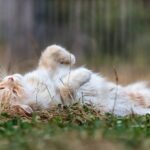Have you ever looked into your cat’s eyes and felt like you were witnessing a profound transformation? Cats, those mysterious and enchanting companions, often leave us guessing about what’s going on in their hearts. But what if you could spot clear signs that your feline is blossoming emotionally? The truth is, cats show their growth in subtle, sometimes surprising ways. From reserved kittens to confident adults, their habits reveal a secret world of trust, love, and self-assurance. Understanding these habits isn’t just heartwarming—it’s a window into the soul of your furry friend.
Seeking Out Gentle Physical Contact

When a cat seeks out your touch, it signifies something special. It isn’t just about warmth or comfort—this is a powerful sign of trust and emotional connection. In the early days, many cats may shy away from being petted, especially if they’ve had a rough start in life. Over time, emotionally growing felines change. They might curl up beside you, nudge your hand for a chin scratch, or even rest their paw gently on your arm. These gestures show that your cat feels safe, loved, and increasingly bonded to you. The evolution from avoidance to seeking touch is a beautiful testament to their emotional confidence. This habit can develop slowly, but when it appears, it’s a heart-melting sign that your cat is thriving emotionally. Cats who enjoy physical affection often have a deep-rooted sense of security in their environment and with their humans.
Playfulness With Humans and Other Pets

A playful cat is often a happy cat. When your feline starts chasing toys, pouncing on string, or even initiating games with you or other pets, it’s more than just burning off energy. Play reflects a cat’s emotional health. Timid or stressed cats may hide or avoid interaction, but emotionally mature felines begin to express themselves through joyful antics. Play is their way of communicating trust and comfort in their surroundings. Sometimes, a cat who never played as a kitten will suddenly discover the joys of chasing a feather wand as an adult, signaling newfound confidence. When cats invite you or another pet to join the fun, it shows they’re open to connection and positive experiences. This willingness to play is a shining example of emotional growth and contentment.
Using Their Voice for Connection

Cats communicate with more than just meows; they use chirps, trills, and even purrs to connect with those they love. When a cat begins to vocalize intentionally—calling for you, greeting you when you enter a room, or responding to your voice—it signals emotional openness. This habit often develops as a cat becomes more comfortable and confident in their home. For example, a once-silent cat might start “talking” to announce dinner, share excitement, or simply get your attention. Each vocalization is a sign that your cat feels safe expressing needs and emotions. Emotional growth is evident when your cat’s sounds become a language of love between you. Over time, this back-and-forth communication can deepen your bond and make every day a conversation.
Displaying Curiosity and Exploration

A secure and emotionally healthy cat will start showing curiosity about their environment. Instead of hiding under the bed, they’ll investigate new rooms, sniff around visitors, and watch the world from the window. This habit is more than just feline nosiness; it reflects a growing confidence and a sense of belonging. When a cat feels safe, their natural explorer comes to life. They might climb to new heights, check out open cabinets, or even follow you from room to room. This urge to explore signals that your cat’s anxiety is fading, replaced by interest and courage. Each new discovery is proof of emotional resilience. Curiosity is a surefire sign that your cat is thriving both mentally and emotionally.
Grooming in Your Presence

Grooming is an essential feline activity, but when a cat chooses to groom themselves around you, it’s a subtle but meaningful gesture. This act shows that your cat feels at ease and unthreatened in your company. Cats are at their most vulnerable when cleaning themselves, so doing so openly is a huge vote of confidence. Some cats might even extend this habit and start grooming you—licking your hand or hair as a sign of affection and trust. Watching your cat take care of themselves so freely is an understated but touching indicator of emotional health. It means your presence brings them peace, and they see you as part of their inner circle. Over time, this habit strengthens the unique friendship between you and your feline.
Using Body Language to Communicate Comfort

Body language in cats is a world of subtlety. An emotionally healthy cat will display relaxed postures—stretched out on their side, showing their belly, or sitting calmly with their tail wrapped around their paws. These positions signal trust and comfort. Eye contact, slow blinks, and gentle tail flicks are other ways cats silently tell you they feel safe. A nervous cat might shrink away or hide, but as they grow emotionally, their body language becomes more open and expressive. The “cat loaf” position, where all paws are tucked in and the cat looks like a cozy loaf of bread, is a classic sign of contentment. Learning to read these signals helps you understand your cat’s evolving emotions and deepening sense of security.
Sharing Their Favorite Spots

Cats are territorial creatures, and their favorite napping or lookout spots are usually sacred. When your feline invites you to share these spaces—by sitting beside you on the couch, curling up on your lap, or even leading you to their favorite sunbeam—it’s a significant sign of emotional growth. This habit means your cat associates you with comfort and happiness. Sometimes, they’ll even bring a treasured toy to you or invite you to sit with them in their chosen spot. By sharing their “safe zones,” cats demonstrate trust and a willingness to strengthen your bond. This act is their way of saying, “You’re part of my world now,” and it is always a privilege when it happens.
Showing Patience and Tolerance

Perhaps the most touching sign of emotional maturity in cats is their ability to display patience and tolerance. A cat that used to run at the slightest noise or sudden movement might now remain calm when the vacuum cleaner rumbles by or a guest enters the room. They may tolerate gentle handling, occasional disruptions, or even the antics of children or other pets. This growth takes time and signals that your cat feels safe enough to let their guard down. Patience doesn’t come easily to all felines, but when it appears, it’s a clear marker of emotional progress. A tolerant, patient cat shows remarkable strength, adaptability, and a deep-rooted trust in their environment.
This is where the summary ends.

Linnea is a born and bred Swede but spends as much time as possible in Cape Town, South Africa. This is mainly due to Cape Town’s extraordinary scenery, wildlife, and atmosphere (in other words, because Cape Town is heaven on earth.) That being said, Sweden’s majestic forests forever hold a special place in her heart. Linnea spends as much time as she can close to the ocean collecting sea shells or in the park admiring puppies.






